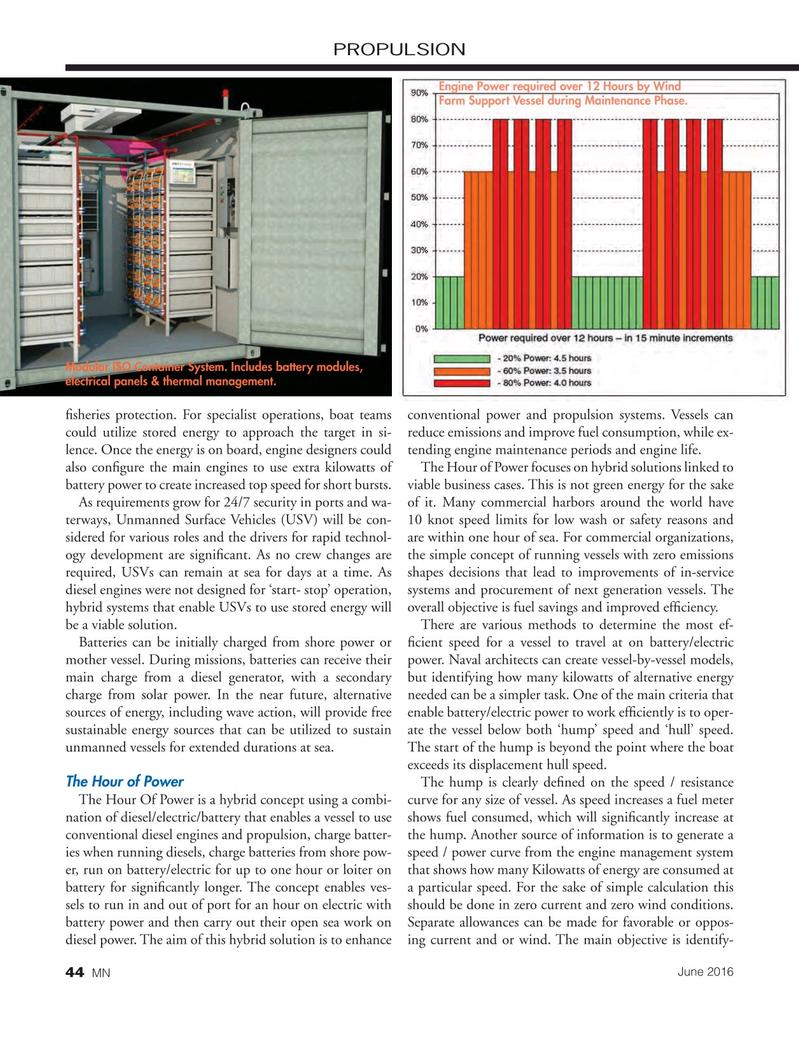
Page 44: of Marine News Magazine (June 2016)
Combat & Patrol Craft Annual
Read this page in Pdf, Flash or Html5 edition of June 2016 Marine News Magazine
PROPULSION
Engine Power required over 12 Hours by Wind
Farm Support Vessel during Maintenance Phase.
Modular ISO Container System. Includes battery modules, electrical panels & thermal management.
? sheries protection. For specialist operations, boat teams conventional power and propulsion systems. Vessels can could utilize stored energy to approach the target in si- reduce emissions and improve fuel consumption, while ex- lence. Once the energy is on board, engine designers could tending engine maintenance periods and engine life.
also con? gure the main engines to use extra kilowatts of The Hour of Power focuses on hybrid solutions linked to battery power to create increased top speed for short bursts. viable business cases. This is not green energy for the sake
As requirements grow for 24/7 security in ports and wa- of it. Many commercial harbors around the world have terways, Unmanned Surface Vehicles (USV) will be con- 10 knot speed limits for low wash or safety reasons and sidered for various roles and the drivers for rapid technol- are within one hour of sea. For commercial organizations, ogy development are signi? cant. As no crew changes are the simple concept of running vessels with zero emissions required, USVs can remain at sea for days at a time. As shapes decisions that lead to improvements of in-service diesel engines were not designed for ‘start- stop’ operation, systems and procurement of next generation vessels. The hybrid systems that enable USVs to use stored energy will overall objective is fuel savings and improved ef? ciency. be a viable solution. There are various methods to determine the most ef-
Batteries can be initially charged from shore power or ? cient speed for a vessel to travel at on battery/electric mother vessel. During missions, batteries can receive their power. Naval architects can create vessel-by-vessel models, main charge from a diesel generator, with a secondary but identifying how many kilowatts of alternative energy charge from solar power. In the near future, alternative needed can be a simpler task. One of the main criteria that sources of energy, including wave action, will provide free enable battery/electric power to work ef? ciently is to oper- sustainable energy sources that can be utilized to sustain ate the vessel below both ‘hump’ speed and ‘hull’ speed. unmanned vessels for extended durations at sea. The start of the hump is beyond the point where the boat exceeds its displacement hull speed.
The Hour of Power The hump is clearly de? ned on the speed / resistance
The Hour Of Power is a hybrid concept using a combi- curve for any size of vessel. As speed increases a fuel meter nation of diesel/electric/battery that enables a vessel to use shows fuel consumed, which will signi? cantly increase at conventional diesel engines and propulsion, charge batter- the hump. Another source of information is to generate a ies when running diesels, charge batteries from shore pow- speed / power curve from the engine management system er, run on battery/electric for up to one hour or loiter on that shows how many Kilowatts of energy are consumed at battery for signi? cantly longer. The concept enables ves- a particular speed. For the sake of simple calculation this sels to run in and out of port for an hour on electric with should be done in zero current and zero wind conditions. battery power and then carry out their open sea work on Separate allowances can be made for favorable or oppos- diesel power. The aim of this hybrid solution is to enhance ing current and or wind. The main objective is identify-
June 2016
MN 44
MN June16 Layout 32-49.indd 44 5/17/2016 10:44:13 AM

 43
43

 45
45
